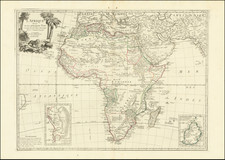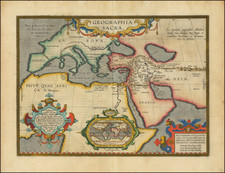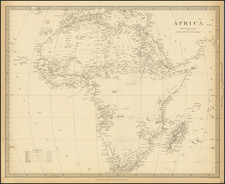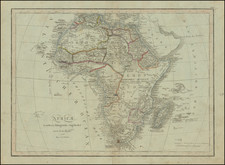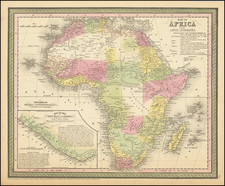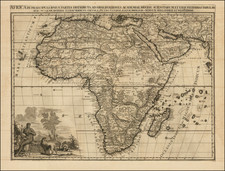Rare and decorative map of Africa, which has caused researcher a fair bit of difficulty in actually placing. In discussing the map of America, Phillip Burden concludes that the work is by Tavernier, based upon early maps by Bertius and identifies several French sources. In fact, we did acquire this map in a set with the America and the Asia maps, the latter which did indeed have Tavernier's name in the credits. Nice detail throughout the map, including elephants, lions, tigers, camels, antelope, monkeys and ostriches, as well as some sort of dragon like creature with wings. Highly detailed. Based upon Hondius' map. Very minor spotting from candle wax, else a nice example of this rare map.
Melchior Tavernier was a member of a large family involved in the publishing trade in Paris in the early years of the seventeenth century. Early in his career, he apparently collaborated with Henricus Hondius, as at least one of his early maps references Tavernier as the seller of a map engraved in Amsterdam, by Hondius. He is probably best known for his publication of a map of the Post Roads of France, which was copied many times until the end of the century. He also issued an atlas under the same title as J. le Clerc's Theatre Geographique, using many of Le Clerc's maps, but incorporating others from different sources. He published composite atlases and also published works for other cartographers, including N. Sanson, N. Tassin, and P. Bertius. He is not to be confused with his nephew of the same name (1594-1665), who also engraved maps for Nicolas Sanson.
Petrus Bertius was a Flemish historian, theologian, geographer, and cartographer. Known in Dutch as Peter de Bert, Bertius was born in Beveren. His father was a Protestant preacher and his family fled to London around 1568. The young Bertius only returned to the Low Countries in 1577, to attend the University of Leiden. A bright pupil, Bertius worked as a tutor and was named subregent of the Leiden Statencollege in 1593. He ascended to the position of regent in 1606, upon the death of the former regent, who was also Bertius’ father-in-law. However, due to his radical religious views, he eventually lost his teaching position and was forbidden from offering private lessons.
His brothers-in-law were Jodocus Hondius and Pieter van den Keere, who were both prominent cartographers. Bertius began his own cartographic publishing in 1600 when he released a Latin edition of Barent Langenes’ miniature atlas Caert Thresoor (1598). He published another miniature atlas that first appeared in 1616.
By 1618, Bertius was named cosmographer to Louis XIII. He converted to Catholicism and took up a position as professor of rhetoric at the Collège de Boncourt (University of Paris). In 1622, Louis XIII created a chart of mathematics specifically for Bertius and named him his royal historian. He died in Paris in 1629.









